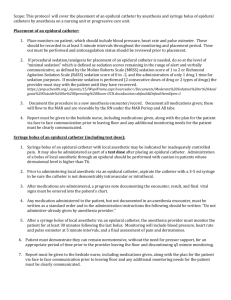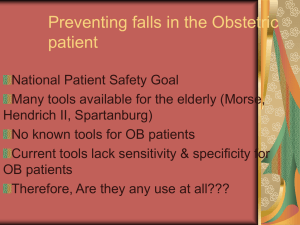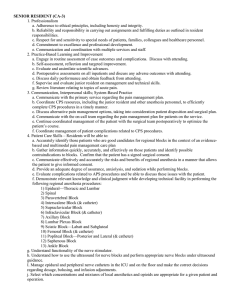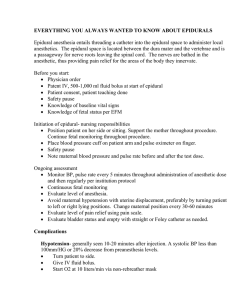Thoracic Epidural: Midline Approach - Procedure Guide
advertisement
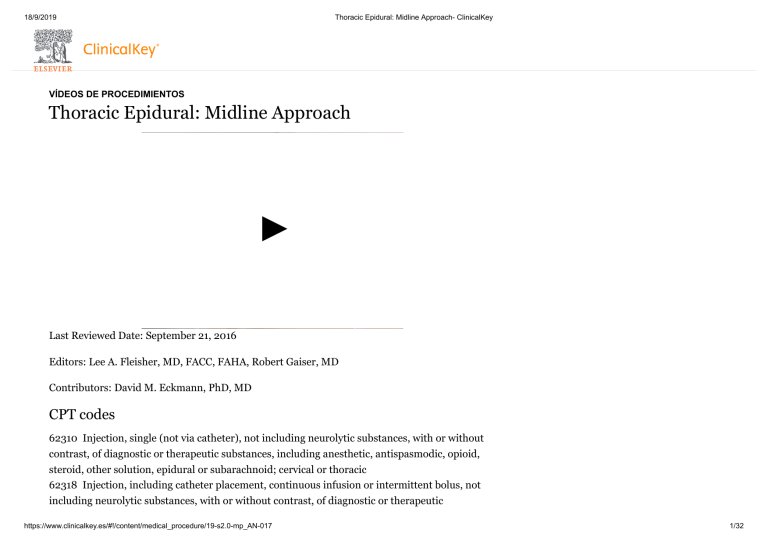
18/9/2019 Thoracic Epidural: Midline Approach- ClinicalKey VÍDEOS DE PROCEDIMIENTOS Thoracic Epidural: Midline Approach Last Reviewed Date: September 21, 2016 Editors: Lee A. Fleisher, MD, FACC, FAHA, Robert Gaiser, MD Contributors: David M. Eckmann, PhD, MD CPT codes 62310 Injection, single (not via catheter), not including neurolytic substances, with or without contrast, of diagnostic or therapeutic substances, including anesthetic, antispasmodic, opioid, steroid, other solution, epidural or subarachnoid; cervical or thoracic 62318 Injection, including catheter placement, continuous infusion or intermittent bolus, not including neurolytic substances, with or without contrast, of diagnostic or therapeutic https://www.clinicalkey.es/#!/content/medical_procedure/19-s2.0-mp_AN-017 1/32 18/9/2019 Thoracic Epidural: Midline Approach- ClinicalKey substances, including anesthetic, antispasmodic, opioid, steroid, other solution, epidural or subarachnoid; cervical or thoracic 62350 Implantation, revision or repositioning of tunnelled intrathecal or epidural catheter, for long-term medication administration via an external pump or implantable reservoir/infusion pump, without laminectomy 64479 Injection, anesthetic agent and/or steroid, transforaminal epidural; cervical or thoracic, single level 64480 Injection, anesthetic agent and/or steroid, transforaminal epidural; cervical or thoracic, each additional level 01967 Neuraxial labor analgesia/anesthesia for planned vaginal delivery (includes repeat subarachnoid needle placement and drug injection and/or any necessary replacement of an epidural catheter during labor) FULL DETAILS PRE-PROCEDURE INTRODUCTION Thoracic epidural anesthesia is primarily a neuraxial block technique for pain management, with applications in surgery and trauma. Both single injection and continuous infusion via an indwelling catheter can be used to provide analgesia intraoperatively as an adjuvant to general anesthesia; postoperatively for analgesia following thoracic and abdominal procedures; and in nonsurgical settings, such as with rib fractures or a flail chest. Injection of local anesthetics and opioid compounds into the thoracic epidural space is a highly effective means of achieving excellent pain management while limiting toxic effects. Thoracic epidural analgesia markedly reduces the surgical effects on ventilatory reserve, including the degree to which patients have diaphragmatic splinting and become unable to generate an adequate cough for clearing secretions. Additionally, thoracic epidural analgesia is associated with better maintenance of pulmonary function in patients having respiratory compromise, including morbidly obese and elderly patients, and patients with intrinsic lung https://www.clinicalkey.es/#!/content/medical_procedure/19-s2.0-mp_AN-017 2/32 18/9/2019 Thoracic Epidural: Midline Approach- ClinicalKey disease, such as chronic obstructive airway disease. Epidural analgesia enables postsurgical thoracotomy or laparotomy patients and patients with thoracic trauma involving rib or sternum fractures to mobilize earlier. It also leads to better cooperation with chest physiotherapy to prevent pulmonary infections. Needle and catheter placement for thoracic epidural anesthesia require familiarity with vertebral anatomy, all equipment, and sterile technique. It is possible to place a thoracic epidural in 5 to 7 minutes in a properly positioned patient. INDICATIONS Thoracic epidurals are used for intraoperative and/or postoperative management of anesthesia and analgesia for operations involving the thorax and upper abdomen. Thoracic epidural analgesia is also used for pain control in some types of thoracic trauma, such as rib fractures.1,2 CONTRAINDICATIONS Absolute contraindications Patient refusal Coagulopathy3,4 Therapeutic anticoagulation Uncorrected hypovolemia Skin infection at insertion site Increased intracranial pressure Thrombocytopenia (platelet count below 50,000/cm3 ) Relative contraindications* https://www.clinicalkey.es/#!/content/medical_procedure/19-s2.0-mp_AN-017 3/32 18/9/2019 Thoracic Epidural: Midline Approach- ClinicalKey Sepsis Anatomical abnormalities of the vertebral column (e.g., spinal stenosis) Neurological disease (e.g., multiple sclerosis) Uncooperative patient Prophylactic antiplatelet medication or low-dose heparin Thrombocytopenia (platelet count below 100,000/cm3 ) Anesthesiologist inexperience * Relative contraindications may be overlooked in cases in which the benefits of analgesia via a thoracic epidural outweigh the risks associated with its placement and use. Presence of neurological disease such as multiple sclerosis or infectious disease such as HIV without central nervous system involvement are often cited as a absolute contraindications to epidural analgesia, but the prevailing evidence is that thoracic epidural analgesia can be safely delivered in such circumstances.1 EQUIPMENT ( See Figure 1 ). https://www.clinicalkey.es/#!/content/medical_procedure/19-s2.0-mp_AN-017 4/32 18/9/2019 Thoracic Epidural: Midline Approach- ClinicalKey Figure 1 Equipment pack demonstrating plastic sterile drape, sterile prep solution, and tray containing from left to right, preservative-free saline, loss-of-resistance syringe, sterile 5-mL syringe, lidocaine 1.5% with epinephrine, 1% lidocaine for subcutaneous infiltration, 20-mL syringe, injection needles, Luer-lock adapter for the epidural catheter, 5-mL syringe, and 18gauge Tuohy epidural needle with stylet in place. The following equipment is used in performing thoracic epidural placement: Standard patient monitors: ECG, blood pressure cuff, pulse oximeter Resuscitation equipment: oxygen, bag and mask, suction Patient must have IV access for IV fluid and medication administration Sterile gloves and mask (some institutions will require sterile gown) https://www.clinicalkey.es/#!/content/medical_procedure/19-s2.0-mp_AN-017 5/32 18/9/2019 Thoracic Epidural: Midline Approach- ClinicalKey Sterile prep kit with drapes Local anesthetics for local infiltration and for epidural injection Adjunct agents for epidural injection; e.g., epinephrine, narcotic 3-mL or 5-mL sterile syringe 30-gauge and/or 25-gauge needles for local anesthetic infiltration Epidural needle: 18-gauge needle with a close-fitting removable stylet to prevent coring of the skin and introduction of epidermal material or other tissue into the epidural or subarachnoid space; two types of needles are commonly used ( see Figure 2 ). The Tuohy needle is probably the most commonly used needle, with a sharp tip and cutting bevel. The end is rounded, with the opening directed laterally, allowing the epidural catheter to thread into the epidural space without producing a sharp bend or kink where the catheter exits the needle. Theoretically, it may be less likely to directly puncture the dura during insertion of the needle or catheter. The Crawford needle has a sharp point and cutting bevel, with a traditionally oriented needle exit. It may allow easier penetration of tissues to the epidural space, and some believe produces a better "loss of resistance." Theoretically could be associated with higher risk of direct puncture of the dura with the needle, kinking of the catheter as it exits the needle, or puncture of the dura with the catheter itself, which is oriented more directly at the dura near the needle exit. https://www.clinicalkey.es/#!/content/medical_procedure/19-s2.0-mp_AN-017 6/32 18/9/2019 https://www.clinicalkey.es/#!/content/medical_procedure/19-s2.0-mp_AN-017 Thoracic Epidural: Midline Approach- ClinicalKey 7/32 18/9/2019 Thoracic Epidural: Midline Approach- ClinicalKey Figure 2 Epidural needles. Left two photographs show a Crawford needle with straight cutting bevel tip and stylet in place. Right two photographs show Tuohy needle with rounded tip and stylet in place. From Miller RD: Miller's Anesthesia. Philadelphia, Elsevier, 2005, p. 1671. Loss-of-resistance syringe: 5 mL, plastic or glass 19-gauge epidural catheter ( see Figure 3 ) Luer-lock adaptor for catheter ( see Figure 4 ) Preservative-free saline Adhesive label for epidural catheter Sterile dressing https://www.clinicalkey.es/#!/content/medical_procedure/19-s2.0-mp_AN-017 8/32 18/9/2019 Thoracic Epidural: Midline Approach- ClinicalKey Figure 3 Epidural catheter. https://www.clinicalkey.es/#!/content/medical_procedure/19-s2.0-mp_AN-017 9/32 18/9/2019 Thoracic Epidural: Midline Approach- ClinicalKey Figure 4 Example of a Luer-lock adapter for epidural catheter. ANATOMY https://www.clinicalkey.es/#!/content/medical_procedure/19-s2.0-mp_AN-017 10/32 18/9/2019 Thoracic Epidural: Midline Approach- ClinicalKey ( See Figure 5 ). Figure 5 Anatomy of the spine and epidural space. https://www.clinicalkey.es/#!/content/medical_procedure/19-s2.0-mp_AN-017 11/32 18/9/2019 Thoracic Epidural: Midline Approach- ClinicalKey The epidural space is the part of the vertebral canal that is not occupied by the dura mater and its contents. It is a potential space existing between the dura mater and the periosteum that lines the inner aspect of the vertebral canal. The epidural space extends from the foramen magnum to the sacral hiatus. Anterior and posterior nerve roots within a dural cuff traverse the epidural space, uniting inside the intervertebral foramen to form segmental nerves. The anterior border consists of the posterior longitudinal ligament, which covers the vertebral bodies, and the intervertebral discs. The epidural space is bordered laterally by the periosteum covering the vertebral pedicles, and the intervertebral foramina. The posterior structures defining its borders are the periosteum of the anterior surface of the lamina and articular processes along with their connecting ligaments, the interlaminar spaces occupied by the ligamentum flavum, and the periosteum covering the spinal roots. The epidural space is rich in venous plexuses and fatty tissue content, which is also continuous with fat present in the paravertebral space.1,2 Recent evidence suggests that the epidural space may be segmented and less uniform than previously thought. Age-related differences, such as decrease in epidural fat content with age, may explain age-related differences in the spread of local anesthetic injected into the epidural space (e.g., higher spread for the same dose of anesthetic as age increases). A dorsomedian band in the midline of the epidural space and the suggestion by computed tomographic epidurography of septa in the epidural space may provide an explanation for nonuniform spread of local anesthetics, which are frequently observed in the clinical setting as unilateral or "patchy" blocks.5 PROCEDURE Explain the procedure to the patient.**OBTAIN CONSENT** Ensure that adequate resuscitation equipment and drugs are available. Ensure that the patient has IV access; preloading with an IV bolus of 500 to 1000 mL of crystalloid solution, such as normal saline or lactated ringer's solution, is recommended, depending on the volume status and medical condition of the patient. https://www.clinicalkey.es/#!/content/medical_procedure/19-s2.0-mp_AN-017 12/32 18/9/2019 Thoracic Epidural: Midline Approach- ClinicalKey Place the patient in a sitting position ( see Figure 6 ). Alternatively, thoracic epidurals may be placed with the patient in lateral decubitus position, as described in spinal anesthesia. See Spinal Anesthesia: Subarachnoid Block for further details. Apply monitors (noninvasive blood pressure, pulse oximeter). Apply nasal cannula oxygen. Provide intravenous sedation as necessary Administering sedation to a patient in sitting position may increase risk of fainting or falling. Be sure that the patient is adequately supported by an assistant. Sitting position may be relatively contraindicated if the patient is prone to fainting. Wear a mask, and scrub and glove carefully.**STERILE TECHNIQUE** Surgically prep the area using chlorhexidine, and drape with a sterile drape. Open and examine the contents of the sterile equipment tray, noting that any sterilization indicators or seals are intact. Check the expiration dates of all injectable materials, and ascertain that sterile saline is preservative free. Prepare any injection agents and mixtures using sterile technique, carefully assuring that no contamination of drugs with prep solution occurs. Palpate the posterior thoracic spinous processes and determine midline and the appropriate interspace (the inferior angle of the scapula is located at T8) ( see Figure 7 ). Note: The description in this chapter is for the midline approach to epidural placement. Thoracic epidurals may also be placed using a paramedian approach. See Paramedian Epidural Placement for further information. Using a small (25- to 30-gauge) injection needle, inject local anesthetic under the skin to produce a small skin wheal over the introduction site. Infiltrate local anesthetic (usually 1% lidocaine) by passing the needle through the wheal deeper under the skin and subcutaneous tissues. In very thin patients, it is possible to introduce local anesthetic intended for https://www.clinicalkey.es/#!/content/medical_procedure/19-s2.0-mp_AN-017 13/32 18/9/2019 Thoracic Epidural: Midline Approach- ClinicalKey subcutaneous infiltration into the subarachnoid space. This can result in therapeutic "spinal" anesthetic levels and increases the risk of post–dural puncture headache. Direct the epidural needle with the stylet in place and the bevel oriented cephalad at a 60degree angle to the back, and carefully insert it beyond the interspinous ligament (about 3 cm depth) ( see Figure 8 ). Remove the stylet and attach the loss-of-resistance syringe containing several mL of preservative-free saline. Advance the needle in small steps (2-3 mm). Test for loss of resistance with each movement of the needle tip by gently pressing on the plunger until loss of resistance is achieved. This indicates needle tip entry into the epidural space. Note the depth of needle insertion using the needle markings on the barrel. At this point, local anesthetic may be given through the needle itself. Some controversy exists, since no "test dose" is given to ensure that the needle tip is not intravascular or subarachnoid in location. However, studies indicate that "through the needle" injection of the first dose of local anesthetic leads to more rapid onset of block, and facilitates threading of an epidural catheter with decreased risk of paresthesia or patchy block.6 Remove the syringe and thread 4 to 5 cm of catheter beyond the needle tip into the epidural space. Knotting of the epidural catheter has been reported when more than 4 to 5 cm of catheter is inserted.7,8 If the catheter does not advance easily, ask the patient to inhale deeply. Alternatively, rotate the needle 15 degrees clockwise or counterclockwise. Inability to thread the catheter is usually a sign of a "false" loss of resistance. Replacement of the needle and catheter is indicated. If the catheter will not advance, DO NOT pull it back through the needle; remove the needle and catheter together to prevent shearing off a portion of the catheter into the epidural space. https://www.clinicalkey.es/#!/content/medical_procedure/19-s2.0-mp_AN-017 14/32 18/9/2019 Thoracic Epidural: Midline Approach- ClinicalKey If the patient experiences pain or has a paresthesia during catheter insertion of the catheter, the catheter or needle may be encountering a nerve root. It is not uncommon for patients to feel a brief pain with catheter insertion. This should resolve immediately. If the sensation persists, the catheter and/or needle should be withdrawn and replaced. https://www.clinicalkey.es/#!/content/medical_procedure/19-s2.0-mp_AN-017 15/32 18/9/2019 Thoracic Epidural: Midline Approach- ClinicalKey Figure 6 Patient in sitting, flexed position. https://www.clinicalkey.es/#!/content/medical_procedure/19-s2.0-mp_AN-017 16/32 18/9/2019 Thoracic Epidural: Midline Approach- ClinicalKey Figure 7 Insertion of epidural catheter. https://www.clinicalkey.es/#!/content/medical_procedure/19-s2.0-mp_AN-017 17/32 18/9/2019 Thoracic Epidural: Midline Approach- ClinicalKey Figure 8 Epidural catheter threaded 4 to 5 cm into epidural space. After inserting the catheter, remove the needle while pushing forward on the catheter to avoid withdrawal of the catheter with the needle. Attach the Luer-lock adapter to the exposed catheter tip. Aspirate the catheter to assess absence of return of blood or cerebrospinal fluid (CSF). If blood returns through the catheter, withdraw the catheter in 1-cm increments until blood can no longer be freely aspirated. Leave at least 3 cm of the catheter within the https://www.clinicalkey.es/#!/content/medical_procedure/19-s2.0-mp_AN-017 18/32 18/9/2019 Thoracic Epidural: Midline Approach- ClinicalKey epidural space. If CSF is freely aspirated, consider managing the catheter as an appropriately labeled intrathecal catheter or withdraw the catheter completely and replace the epidural at another interspace. Inject a test dose of local anesthetic (3 mL 1.5% lidocaine with 1:200,000 epinephrine). Assess the patient for signs of intravascular or intrathecal injection. Development of tinnitus, sudden metallic taste, or perioral dysesthesia is a sign of intravenous injection of local anesthetic. Development of tachycardia and/or hypertension is a sign of intravenous injection of epinephrine. Both blood pressure and pulse should be monitored. Particularly in patients taking beta-blockers, intravascular injection of epinephrine can result in hypertension without tachycardia. Rapid onset of abdominal or buttock numbness may be a sign of subarachnoid injection of local anesthetic. Following a negative test dose, secure the catheter in place. Incrementally inject an induction dose of the chosen local anesthetic. Keep the catheter capped or otherwise attached to an infusion line or syringe to prevent contamination. Choice of Local Anesthetic Agent and Adjuncts The choice of local anesthetic for epidural use depends on such factors as the length of the surgery (particularly in the case of "through-the-needle" single-shot injection), the desired rapidity of onset, and the nature of the block desire. Is a full motor block with complete sensory absence the goal? Or is the goal analgesia without necessarily causing motor blockade (as in pain control for chest trauma)? In general, the speed of onset, spread of https://www.clinicalkey.es/#!/content/medical_procedure/19-s2.0-mp_AN-017 19/32 18/9/2019 Thoracic Epidural: Midline Approach- ClinicalKey analgesia, and degree of motor blockade are related more to the volume and concentration of anesthetic agent used and less to patient position during injection than with spinal anesthesia. Increasing dose (concentration × volume) is associated linearly with increasing sensory blockade, whereas increasing concentration is associated with decreased time of onset and increased intensity of motor blockade. Common drugs and concentration used for epidural anesthesia include 2% lidocaine, 0.5% bupivacaine, 3% chloroprocaine, and 0.75% ropivacaine. After 3-mL test dose of 1.5% lidocaine with 1:200,000 epinephrine, 3 to 5 mL of the anesthetic agent will produce a 5 to 10 segment block within 15 minutes. Some typical narcotic adjuncts include preservative-free morphine 2 to 3 mg every 6 hours, or fentanyl 5 to 10 μg/mL at 4 to 8 mL/hr. For pain management, bupivacaine or ropivacaine in dilute concentrations (e.g., 0.05% bupivacaine) may be used with a dilute dose of opiate drug (e.g., fentanyl 2 mg/ml) infused at 5 to 6 mL/hr. POST-PROCEDURE POST-PROCEDURE CARE Post-procedure care should include clearly labeling the catheter as "epidural." Patient monitoring in the postanesthesia care unit after surgery with epidural anesthesia includes routine vital signs and assessment for common side effects of epidural therapeutic agents. Epidural local anesthetic side effects can include changes in mental status if partial intravascular injection or infusion is occurring or if systemic levels of local anesthetic are accumulating. Other possible side effects include hypotension and urinary retention. Epidural narcotic side effects can include late respiratory depression, nausea, vomiting, and urinary retention. If epidural narcotics are used, monitoring for https://www.clinicalkey.es/#!/content/medical_procedure/19-s2.0-mp_AN-017 20/32 18/9/2019 Thoracic Epidural: Midline Approach- ClinicalKey respiratory depression (pulse oximetry, regular assessment every 1 to 2 hours of respiratory rate and function) should continue for at least 24 hours after administration. Periodic assessment of block height is essential, both in the postanesthesia care unit, and routinely whenever an indwelling epidural catheter is in place, as well as for at least the first day after removal of an epidural catheter. Failure of sensory or motor block to recede within a time frame consistent with the pharmacokinetics of the local anesthetic used, or alternatively, progression of apparent sensory or motor blockade without addition of local anesthetic with or without the presence of back pain may be a sign of epidural hematoma or abscess formation. This is an indication for IMMEDIATE assessment for possible mass effect in the epidural space with computerized tomographic scanning or magnetic resonance imaging, and EMERGENCY surgical decompression if hematoma or abscess is present. Daily vital signs should include periodic temperature monitoring as an early warning sign of infection. Daily inspection of insertion site should be made to look for signs of infection, bleeding, or catheter dislodgement. The catheter tip must be inspected upon removal to identify complete retrieval without any portion of the catheter being retained. COMPLICATIONS Common complications Kinking of the catheter: Try withdrawing the catheter 1 cm and reinjecting. Sometimes the catheter will need to be replaced. Blockage or obstruction of the catheter: Try injecting a small amount of preservative-free saline or withdrawing the catheter 1 cm. Catheter may need replacing. https://www.clinicalkey.es/#!/content/medical_procedure/19-s2.0-mp_AN-017 21/32 18/9/2019 Thoracic Epidural: Midline Approach- ClinicalKey Hypotension: usually an early complication 500 to 1000 mL of IV crystalloid fluid should be administered rapidly unless contraindicated. Ephedrine is the vasopressor of choice, because it causes vasoconstriction and raised heart rate, leading to increased cardiac output. Dosing is 2.5 to 10 mg IV. Phenylephrine is a pure peripheral vasoconstrictor, generally available as a singledose vial of 10 mg. It is particularly helpful if tachycardia is present and a second-line treatment of hypotension is needed. Phenylephrine is given as an initial dose of 50 to 100 micrograms IV bolus, or it may be given as a continuous IV infusion titrated to blood pressure. An IV infusion solution with a concentration of 40 micrograms/mL can be made by injecting one 10-mg vial into a 250 mL bag of crystalloid solution. Administration of phenylephrine can lead to reflex bradycardia as blood pressure rises, and it should be used with caution in patients with baseline low heart rates. Epinephrine is available in both 1 mg/mL (1:1000) ampoules, and 1 mg/10 mL (1:10,000) ampoules and syringes. It is usually not used as a first line drug for treatment of hypotension due to spinal anesthesia, but it increases cardiac output by increasing stroke volume and heart rate, and increases blood pressure through peripheral vasoconstriction. It has a greater arrhythmogenic potential than ephedrine or phenylephrine. 4 to 8 micrograms. A 1-mg ampoule injected into 250 mL of crystalloid results in a concentration of 4 micrograms/mL. Urinary retention during epidural therapy: may require placement of a urinary catheter; resolves when effects of the local anesthetic or neuraxial narcotic resolve Infrequent complications: minor and severe Minor bleeding Intravascular catheter placement: Withdraw the catheter in 1-cm increments until blood can no longer be freely aspirated and retest. https://www.clinicalkey.es/#!/content/medical_procedure/19-s2.0-mp_AN-017 22/32 18/9/2019 Thoracic Epidural: Midline Approach- ClinicalKey Dural puncture with the needle or catheter: Dural puncture is often evident when the stylet of the needle is withdrawn and a "rush" of clear fluid results. Clinical Pearls: A small amount of clear fluid from the needle or aspirated from the catheter after placement may represent aspiration of saline used in the loss-of-resistance maneuver and not the presence of CSF. Two indicators that this is not CSF are low temperature of the fluid (CSF is at body temperature), and absence of glucose (CSF contains 50 to 80 mg/dL glucose). A helpful test if in doubt is to use a simple urine dipstick to test for the presence of glucose, or to use a glucometer measurement of glucose. If negative for glucose, it is unlikely that the fluid is CSF. If in doubt, replace the needle or catheter at another interspace. Unintended dural puncture with either an 18-gauge epidural needle or 19-gauge catheter dramatically increases the likelihood of post–dural puncture headache. Post–dural puncture headache Can occur even if no dural puncture is suspected during placement or use of an epidural catheter Incidence is very high if obvious dural puncture occurs with an epidural needle (up to 80%).1 Epidural blood patch is the treatment of choice in most cases. Backache: Early backache is often reported, but evidence for increased risk of long-term back pain following epidural placement is lacking. Even in obstetrical patients, where complaints of back pain following epidural labor analgesia may approach 25%, the incidence and duration of back pain has been found to be similar in patients who did not receive epidural labor analgesia.1 https://www.clinicalkey.es/#!/content/medical_procedure/19-s2.0-mp_AN-017 23/32 18/9/2019 Thoracic Epidural: Midline Approach- ClinicalKey Intrathecal catheter placement Replace the catheter or manage as an intrathecal catheter. This is associated with increased risk of post–dural puncture headache. Rarely, subdural catheter placement can occur, with resulting unanticipated high block. Treat for unintended high epidural block or total spinal anesthesia (see section on serious and rare complications). Consider replacing the catheter. Inadequate or "patchy" block: Consider replacing the catheter. Paresthesia during catheter advancement: If pain does not resolve immediately, remove the needle and catheter and try at another interspace. Respiratory depression with opioid delivery into the epidural space Can occur up to 24 hours after an injection of epidural narcotic Usually is preceded by other side effects of epidural narcotics, such as pruritus, nausea, vomiting, and sedation Treat with continuous infusion of naloxone 0.001 to 0.002 mg/kg/hr (i.e., 1-2 μg/kg/hr) for 12 to 24 hours. Pruritus, nausea, or vomiting associate with epidural narcotics Can be treated with concomitant use of compounds such as butorphanol or buprenorphine May also respond to low-dose infusion of naloxone Delayed local anesthetic toxicity May occur minutes to hours after epidural injection or infusion https://www.clinicalkey.es/#!/content/medical_procedure/19-s2.0-mp_AN-017 24/32 18/9/2019 Thoracic Epidural: Midline Approach- ClinicalKey Systemic toxicity: Symptoms can be CNS depression, somnolence, confusion, complaints of tinnitus, and seizures. STOP epidural infusion or injection Treat agitation and confusion symptomatically. Administration of a benzodiazepine may lower the risk of seizure. Treat seizures with standard resuscitative measures: Intubate, ventilate, provide hemodynamic support if needed, and administer benzodiazepines or barbiturates to control seizure activity. Cardiac toxicity: notorious with bupivacaine toxicity and difficult to treat; ventricular arrhythmias are often the first manifestation; treatment is DC countershock or cardioversion if arrhythmia occurs, cardiopulmonary resuscitation including airway management, and supportive hemodynamic treatment. Neurotoxicity (now rare): Neurologic injury and paralysis was reported with bisulfitecontaining mixtures of chloroprocaine in the early 1980s.9 Reformulated mixtures now are pH-adjusted with bisulfite removed. Direct application of lidocaine through subarachnoid catheters has been associated with increased risk of cauda equina syndrome and can theoretically happen if undetected subarachnoid placement of the epidural catheter or subarachnoid injection of local anesthetic agent occurs.1 Respiratory compromise due to motor block of thoracic segments: Treatment is symptomatic and supportive. Bradycardia due to block of cardiac accelerator fibers Atropine 0.4 to 0.8 mg IV bolus is the initial treatment of choice. Second line drugs include ephedrine (2.5-5 mg IV) or epinephrine (10-50 μg IV). https://www.clinicalkey.es/#!/content/medical_procedure/19-s2.0-mp_AN-017 25/32 18/9/2019 Thoracic Epidural: Midline Approach- ClinicalKey Retained epidural catheter or catheter fragment: previously thought to be innocuous, but has now been associated with complications of radicular pain and lumbar stenosis at the site of the retained catheter.7,8 If resistance is encountered when removing the epidural catheter, have the patient assume a maximally flexed position (head down, knees up) and gently pull. Clinical Pearls: Removal of an epidural catheter requires less force if the patient is in the lateral decubitus position rather than sitting. If after repositioning the patient, the catheter will still not come out, tape the catheter to the patient's back under slight tension, and return later after the patient has been allowed to relax for several hours. Several authors have reported successful removal of the catheter after these measures. For retained fragment of the catheter (the catheter comes out missing its marked tip), reported long-term sequelae include radicular pain and lumbar stenosis. Estimate how much material is retained using the measuring marks on the catheter. INFORM the patient that a fragment of catheter remains inside. Consider CT or MRI to document position of the fragment. Consider consult with a neurosurgeon, particularly if the patient appears to be experiencing symptoms from the retained fragment. Serious and rare Unintended high epidural block or total spinal anesthesia: Treatment is symptomatic and supportive. See the complications section in Spinal Anesthesia: Subarachnoid Block for more information. https://www.clinicalkey.es/#!/content/medical_procedure/19-s2.0-mp_AN-017 26/32 18/9/2019 Thoracic Epidural: Midline Approach- ClinicalKey Epidural hematoma: Failure of a motor or sensory block to recede in an appropriate length of time, rapid onset or progression of neurological deficit, and the presence of back pain are absolute indications for early investigation and decompression. Epidural abscess or infection: Severe back pain, local back tenderness, fever, and leukocytosis following epidural anesthesia or analgesia are absolute indications for early investigation, decompression, and antibiotic therapy, even if neurologic deficit is not present. Spinal cord injury Anterior spinal artery syndrome: Direct trauma during epidural placement and/or low spinal cord perfusion pressure have been reported to be risks for anterior spinal artery syndrome. Arachnoiditis or transverse myelitis: may be due to chemical contamination of the local anesthetic solution; local anesthetics used for epidural injection should be preservative-free, and care should be taken to avoid contamination with the anesthetic by chemical prep solutions. ANALYSIS OF RESULTS OUTCOMES AND EVIDENCE Epidural anesthesia, alone or in conjunction with general anesthesia, has been shown to be a safe alternative for many surgeries when compared with general anesthesia alone. Although epidural anesthesia may be the best choice for safety and efficacy in some individual patients, numerous studies have failed to demonstrate that regional anesthesia is safer or more effective than general anesthesia overall. Rodgers et al.10 found in a meta-analysis of 141 trials that overall mortality appeared to be lower with epidural anesthesia compared to general anesthesia, with associated reductions in deep venous thrombosis (DVT), pulmonary embolism, transfusion requirements, respiratory depression, myocardial infarction and renal failure. Christopherson et al.11 showed no difference in general anesthesia compared with epidural anesthesia with respect to https://www.clinicalkey.es/#!/content/medical_procedure/19-s2.0-mp_AN-017 27/32 18/9/2019 Thoracic Epidural: Midline Approach- ClinicalKey postoperative mortality, nonfatal perioperative myocardial infarction, myocardial ischemia, infection, renal failure, or pulmonary complications. However, a significant difference was seen in postoperative peripheral vascular ischemic complications, favoring epidural anesthesia over general anesthesia. Although differences in mortality have been hard to prove, some benefits have been shown for epidural anesthesia and epidural analgesia that bear consideration. In 1991, Tuman et al.12 demonstrated that for vascular surgery patients, general anesthesia combined with epidural anesthesia and epidural postoperative analgesia was associated with a lower risk of postoperative thrombotic complications and shorter duration of ICU stay when compared to general anesthesia and on-demand postoperative narcotic analgesia. This was associated with thromboelastographic evidence of decreased platelet–fibrinogen interaction in the epidural patients. In patients undergoing hip and knee surgery, epidural anesthesia and analgesia was found by Donatelli et al.13 to be associated with lower rates of insulin resistance. Kopeika et al.14 found that thoracic epidural postoperative analgesia in patients undergoing thoracotomy for lung cancer was associated with a lower risk overall of postoperative complications, improved lung function 24 hours after surgery, and better analgesia scores than intramuscular opiate analgesia. In a meta-analysis of 10 trials comparing general anesthesia with neuraxial block for total hip replacement surgery, Mauermann and co-workers15 found that neuraxial blockade was associated with lower risk of transfusion, deep venous thrombosis, and pulmonary embolism than patients undergoing general anesthesia. Meta-analysis of 66 articles comparing spinal, epidural, and general anesthesia was found by Richman et al.16 that spinal and epidural anesthesia were associated with less blood loss than general anesthesia. Analgesia with thoracic epidural narcotics for multiple rib fractures has also been shown to be associated with better analgesia, shorter length of mechanical ventilation, shorter duration of ICU stay, and lower rates of tracheostomy than treatment with standard parenteral narcotics.17 REFERENCES 1. Brull R, Macfarlane A JR, Chan VWS:Spinal, Epidural and Caudal Anesthesia. IN: Miller's Anesthesia 8th Edition. Miller RD, Editor. Elsevier Inc, Philadelphia PA. 2015. pp. 1684-1720 https://www.clinicalkey.es/#!/content/medical_procedure/19-s2.0-mp_AN-017 28/32 18/9/2019 Thoracic Epidural: Midline Approach- ClinicalKey 2. Brown DL:Epidural Block. IN: Brown's Atlas of Regional Anesthesia, 5th Edition. Elsevier Inc, Philadelphia 2017, pp 279-290. 3. Horlocker TT, Wedel DJ, Benzon H, et al.: Regional anesthesia in the anticoagulated patient: defining the risks (the second ASRA Consensus Conference on Neuraxial Anesthesia and Anticoagulation). Reg Anesth Pain Med. 2003 May-Jun;28(3):172-97. 4. Horlocker TT, Wedel D, Rowlingson JC, et al.: Regional anesthesia in the patient receiving antithrombotic or thrombolytic therapy: American Society of Regional Anesthesia and Pain Medicine EvidenceBased Guidelines (Third Edition). Reg Anesth Pain Med. 2010 Jan-Feb;35(1):64-101. 5. Russell R:Loss of resistance to saline is better than air for obstetrical epidurals. Int J Obstet Anesth 2001; 10: pp. 302. 6. Cesur M, Alici H, Ali E, et al: Administration of local anesthetic through the epidural needle before catheter insertion improves the quality of anesthesia and reduces catheter-related complications. .Anesth Analg 2005; 101: pp. 1501. 7. Gozal D, Gozal Y, Beilin B: Removal of knotted epidural catheters. .Reg Anesth 1996; 21: pp. 71. 8. Pierre HL, Block BM, Wu CL: Difficult removal of a wire-reinforced epidural catheter. .J Clin Anesth 2003; 15: pp. 140. 9. Wang BC, Hillman DE, Spielholz NI, Turndorf H.: Chronic neurological deficits and Nesacaine-CE-an effect of the anesthetic, 2-chloroprocaine, or the antioxidant, sodium bisulfite? Anesth Analg. 1984 Apr;63(4):445-7. 10. Rodgers A, Walker N, Schug S, et al: Reduction of postoperative mortality and morbidity with epidural or spinal anesthesia: results from overview of randomized trials. .Br Med J 2000; 321: pp. 1493. 11. Christopherson R, Beattie C, Frank SM, et al: Perioperative morbidity in patients randomized to epidural or general anesthesia for lower extremity vascular surgery. .Anesthesiology 1993; 79: pp. 422. https://www.clinicalkey.es/#!/content/medical_procedure/19-s2.0-mp_AN-017 29/32 18/9/2019 Thoracic Epidural: Midline Approach- ClinicalKey 12. Tuman KJ, McCarthy RJ, March RJ, et al: Effects of epidural anesthesia and analgesia on coagulation and outcome after major vascular surgery. .Anesth Analg 1991; 73: pp. 696. 13. Donatelli F, Vavassori A, Bonfanti S, et al: Epidural anesthesia and analgesia decrease the postoperative incidence of insulin resistance in preoperative insulin-resistant subjects only. .Anesth Analg 2007; 104: pp. 1587. 14. Kopeika U, Taivans I, Udre S, et al: Effects of the prolonged thoracic epidural analgesia on ventilation function and complication rate after the lung cancer surgery. .Medicina (Kaunas) 2007; 43: pp. 199. 15. Mauermann WJ, Shilling AM, Zuo Z: A comparison of neuraxial block versus general anesthesia for elective total hip replacement: a meta-analysis. .Anesth Analg 2006; 103: pp. 1018. 16. Richman JM, Rowlingson AJ, Maine DN, et al: Does neuraxial anesthesia reduce intraoperative blood loss? A meta-analysis. .J Clin Anesth 2006; 18: pp. 427. 17. Ullman DA, Fortune JB, Greenhouse BB, et al: The treatment of patients with multiple rib fractures using continuous thoracic epidural narcotic infusion. .Reg Anesth 1989; 14: pp. 43. Checklist Explain the procedure and obtain consent. Secure: IV access O2supplementation Standard monitoring Resuscitation equipment Sedation (if indicated) https://www.clinicalkey.es/#!/content/medical_procedure/19-s2.0-mp_AN-017 30/32 18/9/2019 Thoracic Epidural: Midline Approach- ClinicalKey Place the patient sitting. Use sterile technique; prep and drape the area. Ensure contents of the tray are sterile; check expiration dates and ensure the saline is preservative-free. Palpate the posterior thoracic spinous processes and determine midline and the appropriate interspace for the site of entry. Anesthetize the site. Introduce the Touhy needle at a 60-degree angle to the skin and insert it beyond the interspinous ligament (about 3 cm depth). Remove stylet and attach the loss-of-resistance syringe. Advance the needle in small steps (2-3 mm) until there is loss of resistance and note depth. Remove the syringe and thread 4 to 5 cm of catheter beyond the needle tip. Remove the needle and attach the Luer-Lok. Aspirate, then inject a test dose (3 mL 1.5% lidocaine with 1:200,000 epinephrine) and assess for signs of intravascular or intrathecal injection before continuing anesthetic infusion. Secure the catheter in place and apply sterile dressing. https://www.clinicalkey.es/#!/content/medical_procedure/19-s2.0-mp_AN-017 31/32 18/9/2019 Thoracic Epidural: Midline Approach- ClinicalKey Copyright © 2019 Elsevier, Inc. Todos los derechos reservados. https://www.clinicalkey.es/#!/content/medical_procedure/19-s2.0-mp_AN-017 32/32
